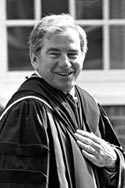Thomas Hedley Reynolds

When President Thomas Hedley Reynolds retired after serving Bates, from 1967 to 1989, he could say that of the 159 faculty members, all but 16 had been appointed during his presidency. While key facility improvements also marked his tenure, the championing of the Bates faculty was perhaps his greatest achievement.
“President Reynolds has given us more time, more colleagues, and perhaps above all else, more self-esteem,” said a member of the history faculty John R. Cole, in 1989. “The result is that a good college of good teachers has become a better college of better teachers.”
An early move towards this achievement was Reynolds’ emphasis on improving salaries in an effort to attract and retain high-quality faculty. Bates achieved greater gender equity during the Reynolds years, as well as an improved faculty-student ratio and an average class size of 15.
Furthermore, Reynolds also encouraged closer faculty involvement in the governance of the College through elected committees as well as the expansion of the sabbatical program. His own experience as a teacher and a scholar allowed Reynolds to recognize teaching and scholarship as complimentary professorial activities (previous administrations had viewed the two as generally antithetical), leading Reynolds to encourage faculty research and creativity.

Arriving at Bates during a tumultuous time for U.S. colleges, Reynolds was also faced with students upset by strict campus social rules reflecting 1950s sensibilities. He guided the College through the campus tensions of the late 1960s and 1970s with a renewed emphasis on involving all members of the community in decision-making.
Significant renovations and physical additions to the campus include the George and Helen Ladd Library, Merrill Gymnasium and Tarbell Pool, the Olin Arts Center with its Bates College Museum of Art, the conversion of the former women’s athletic building into the Edmund S. Muskie Archives, and the acquisition of the Bates-Morse Mountain Conservation Area. The houses on Frye Street, a popular and creative residential alternative to traditional dormitory housing, were also acquired primarily during the Reynolds presidency.